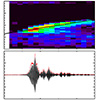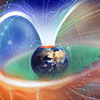
2020 THEMIS SCIENCE NUGGETS
SUMMARIES OF THEMIS RESEARCH
| <<View 2019 THEMIS Nuggets | Return to main page |
 Guang Qing Yan, February 2020
Guang Qing Yan, February 2020THEMIS Probes Observed Plasma Transport into the Magnetosphere in Kelvin-Helmholtz vortices
Multi-satellite observations show the formation and evolution of Kelvin-Helmholtz vortices at the magnetosphere boundary during a turn toward northward IMF, confirming intrusion of cold solar wind plasma into the magnetosphere. Read more.
 Lauren Blum, February 2020
Lauren Blum, February 2020Multipoint measurements to understand the structure, generation, and impact of EMIC wave activity in the inner magnetosphere.
Here we combine measurements from multiple spacecraft around the Earth to study EMIC wave generation, structure, and impacts in the inner magnetosphere. While these waves are often thought to be localized and of short durations, we observe an event on 07 July 2013 where waves persist for over 10 hours and span the entire night-side of the Earth. Events like these have the potential to cause significant effects in the particle populations around the Earth. Read more.
 Longzhi Gan, February 2020
Longzhi Gan, February 2020Nonlinear Interactions Between Radiation Belt Electrons and Chorus Waves: Dependence on Wave Amplitude Modulation.
Test particle simulations are performed to evaluate nonlinear interactions between radiation belt electrons and three models of chorus waves based on the THEMIS observation. We quantify the nonlinear effects of chorus waves on radiation belt electrons, focusing on their dependence on the wave amplitude modulation, within a large range of electron pitch angles and energies. Read more.
 Ying Zou, February 2020
Ying Zou, February 2020Azimuthal variation of magnetopause reconnection at scales below an Earth radius.
The structure of magnetopause reconnection in the azimuthal dimension determines how much energy is imparted to the magnetosphere, and the knowledge has been limited by the available spacecraft constellations. Here we use serendipitous THEMIS constellations with a spatial size at a less explored scale size, which is few tenths of Earth radii, to explore the azimuthal variation of reconnection. Read more.
 Andy Smith, March 2020
Andy Smith, March 2020An investigation into the near-Earth source of magnetic ultra-low frequency (ULF) waves at substorm onset
We compared and contrasted ground- and space-based THEMIS observations, confirming the approximate location of the source region in near-Earth space. Read more.
 Fei He, March 2020
Fei He, March 2020Plasmapause surface wave oscillates the magnetosphere and diffuse aurora
We show direct observations of a plasmapause surface wave excited by plasma injection and its impacts during a geomagnetic storm. The wave oscillates the plasmapause in the afternoon-dusk sector, triggers sawtooth auroral displays, and drives outward-propagating ultra-low frequency waves. Read more.
 Shun Imajo, April 2020
Shun Imajo, April 2020Evolution of field-aligned current in the meridional plane during substorm: multipoint observations from satellites and ground stations
The magnetic fluctuations associated with a substorm reflect the structure and development of substorm current systems. In this study, the meridional distribution of the magnetic fluctuations during a substorm is revealed by simultaneous observations near and far away from the equator, in the magnetosphere and with conjugate ground observations. Read more.
 Please send comments/suggestions to
Emmanuel Masongsong / emasongsong @ igpp.ucla.edu
Please send comments/suggestions to
Emmanuel Masongsong / emasongsong @ igpp.ucla.edu